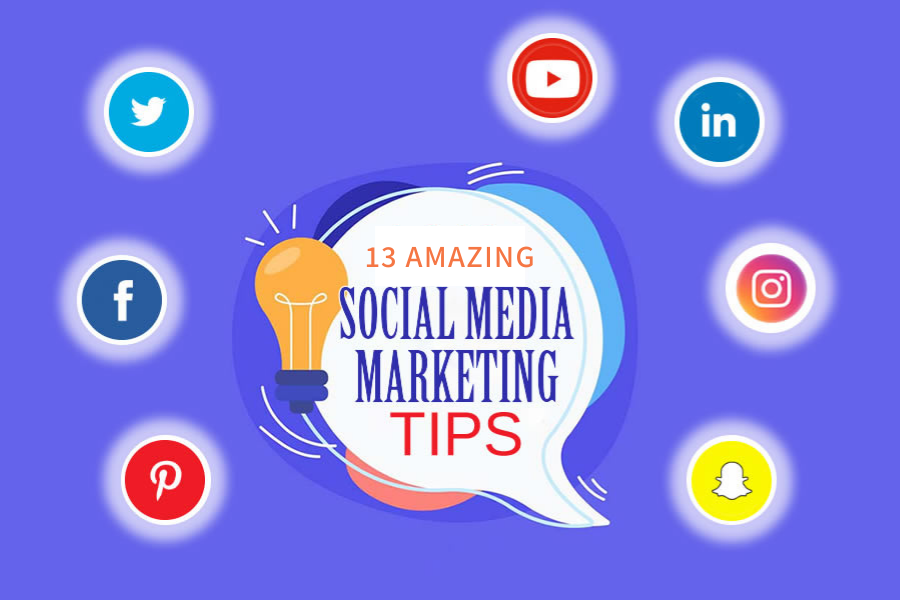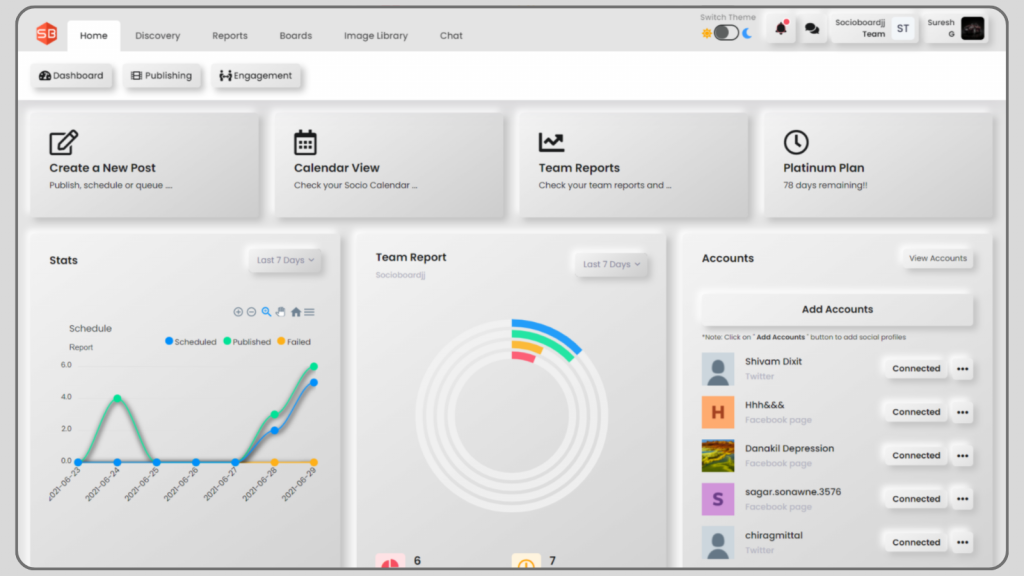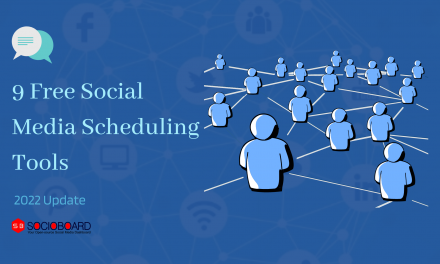Both new and well-established brands are using social media to grow their audience, generate leads, and increase sales. Creating a brand using social media might feel like a huge project with so much variety in available platforms. But it’s easier to connect with people and grow your brand organically when you have the best social media marketing tips.
There are now more than 4.2 billion active social media users, almost twice than there were just five years ago. The average time spent on social media of those users is 2 hours and 25 minutes every single day.
Those nearly 2.5 hours present an excellent opportunity for businesses to create brand awareness, evolve customer relationships, and even make sales directly within social platforms.
But, it is easier said than done, unless you have a solid strategy. And we are here to help you along the way. Whether you’re undertaking a brand-new social media marketing campaign or optimizing a proceeding initiative, these tips will come in handy. In this article, we’ll cover social media marketing tips and tricks you can apply that will optimize your marketing strategy.
Lay Out Your Goals And Objectives:
Having a solid plan, objectives, and goals are imperative if you want to jump start your social media strategy.
If you don’t know what you want, how are you supposed to achieve it?
Not to mention, you can’t measure or evolve your strategies over time if you don’t have strong goals, to begin with.
Your social media goals should align with your overall marketing efforts.
Writing down your goals is paramount if you want to reach them.
According to a study, you’re 30% more likely to be successful if you write your goals down. In some studies that number is as high as 40%.
When you set your goals, make them attainable and break them down into smaller action steps.
Research And Learn About Your Audience:
Connecting and engaging with your audience is crucial in today’s marketing if you want to turn a profit.
But, to do that, you need to understand your audience – inside and out.
You should be able to pinpoint their needs, wants, and desires -if you have a hope of creating a successful social media strategy.
Here’s how you can better understand your audience!
- Survey your audience to better grasp their pain points
- Look carefully at their demographics
- Take part in conversations on forums filled with your target audience
- Respond to comments on your blog, and comment on other blogs with the same target audience
- Reply to all comments or questions on your social media channels
- Collect feedback (using one of the many user feedback tools available)
Once you get a feel for who your target audience is, you’re better equipped to help them. They want to deal with businesses that care – not just a faceless brand.
Which makes this a vital step in creating any social media strategy.
Create A Specific Strategy For Each Social Media Platform:
In the same way, you prepare other aspects of your marketing plan, you need to have a specific and intentional plan for each platform you use. Each platform has nuances and best practices for generating engagement. Your brand may not need to have a presence on every platform, but for your posts to be targeted, you need to have a strategy that is specific to the platform you’re using.
Make sure you can answer questions like:
- Why am I using this platform?
- Who will reach on this platform?
- What post types work best on this platform?
- How are my posts unique to this platform?
If you have a hard time answering these questions, it might be time to dig deeper into why you’re investing time there. Answering these questions will also help you develop your strategy for that platform.
If you’re just getting started, prioritize the quality of your content over the number of posts and sites that you use. For most businesses, particularly small businesses, trying to tackle a new strategy on five different social media networks often results in doing a mediocre job with little to no results.
Let The Tools Empower Your Strategy:
Social media tools are going to be your savior. Imagine being on 8 different platforms and posting manually on each of them 3 times a day.
Damn, what a nightmare! All you’ll possibly do is publish hastily without any real productivity.
So, let’s leave the monotonous work for the tools, shall we?
Yup, that is possible! Try to automate as much of the activity as possible. For example, schedule your social media updates ahead of time.
Use social media scheduling tools like Socioboard to auto-post your updates to all your social accounts, then evaluate the results with the analytics they provide.
Save time and grow your small business using Socioboard. From a single dashboard, you can publish and schedule messages to all your social media channels, engage your followers, and monitor what people are saying about your brand online.
Run Contests To Amp Up Your Social Media Strategy:
Crafting a successful social media contest is one of the most alluring tactics you can use. It’ll increase your online visibility, your followers, and your engagement.
There are several social content tools you can use to create an outstanding giveaway or sweepstakes.
The key to executing a successful contest is offering something of tremendous value.
Something that’ll be irresistible to your audience.
- figure out your goals (do you want more Facebook page likes? Instagram followers? How many?)
- Decide what social media channel you’ll host the contest on
- Come up with a deadline for when it’ll end and when the winner will receive their prize
- Create the contest (look at different types and choose the right one for your audience)
- Promote it with all your might!
To get mind-blowing results, aim to have your audience do some of the heavy liftings.
Set the contest up so they get extra entries for sharing the contest or completing similar tasks.
Such as: “Pin on Pinterest”, “Share on Facebook”, or “Like my Facebook page”. You can also give them a unique link to share for extra entries.
It’s genius. Your contest will basically run itself!
Craft Your Social Media Content Carefully:
Every piece of content you post on social media should be carefully thought-out. If you’re posting just to post something – you’re going about it all wrong.
Depending on the social network you’re posting on, you’ll need to learn the various purposes of each network.
Here are some examples:
- LinkedIn – A professional network that is perfect for B2B audiences. Also includes LinkedIn Pulse, a content publishing and distribution platform.
- Facebook – Almost everyone has a Facebook account. Particularly good for news/entertainment-related content. While Facebook Pages struggle to perform, Facebook Groups can be a great way of connecting with your ideal audience.
- Instagram – Perfect if your content is highly visual. Static images and short videos work incredibly well but it’s not as good at driving traffic back to your blog.
- Pinterest – Similar to Instagram, Pinterest is highly visual. Although it’s limited to static images, it can be highly effective at driving traffic back to your blog.
Planning and creating content can be time-consuming but the right tool can make this process far easier. Check out our roundup of the best social media calendar tools to find out how.
Once you learn about the varying networks, you can focus on which ones you think will mesh well with your business.
Use The Art Of Storytelling:
It’s the stories that sell, not the product! We, humans, connect to stories. It is the emotional attachment that a brand builds with its audience. Stories inspire ideas and encourage interaction.
There are simpler ways too to move your audience. Share successive posts to relate the whole story from the beginning to the end. The blow-by-blow arouses excitement that is great to make your story compelling.
Be Consistent:
How consistently you post should be specific to each social media site you’re utilizing. Some platforms like Twitter and Instagram Stories require you to be active multiple times per day to get the maximum potential from your audience. Other post types, like regular Instagram posts and Facebook updates, don’t have as much urgency and can be used less sparingly. When determining your post strategy, look at factors such as how the algorithm works for each platform and whether content posts chronologically or is curated based on other factors.
This ties back in with your social media marketing plan. You should outline:
- How often do you plan to publish on each social media platform based on best practices for that platform
- What type of content do you plan to post on each platform
- Who is your target audience on each platform
Keep An Eye On What’s Trending:
Once you have your key messaging determined, keep an eye on popular trends emerging on each platform. If you notice a pattern or strategy rising in popularity and it aligns with your messaging, then it’s a great idea to capitalize on it to drive engagement.
Be wary of jumping on board every new internet trend you see. Creating posts that don’t align with your overall messaging to appear relevant is a quick way to alienate your target audience. You never need to create a particular type of content just because you see other brands doing it.
This is why it’s so essential to create a focused message that you can use as a baseline against which to measure all of your future social media posts.
Create A Social Media Content Calendar:
There is a saying – failing to plan is planning to fail.
No matter what you do, without planning, you are going to fail in social media marketing! So, use social media content calendars tools to organize and publish all your content timely and efficiently.
Content calendars also help to distribute resources effectively, improve team collaboration and give a more in-depth understanding of what works and what doesn’t.
You’ll find ample templates online to pen down your calendar. You can use Socioboard tools to plan your content calendar.
The best thing about these tools is that it enables you to put up images, set timings for your posts for multiple social media, and much more from a single dashboard.
Just create and update the publishing calendar once a week, build team sections, and distribute the file to co-workers to get their comments before posting.
Don’t Let Your Mistakes Stop You:
We are all humans, and we make mistakes. This is especially essential to accept in the fast-growing world of social media. Instead of being ignorant of your mistakes, accept and apologize for the same. Work on them and tell your customers about them. They’ll love to hear that you worked on your mistakes to provide them with better services.
If you’ve made a grammar mistake or missed a comma, don’t delete the post. Probably, people liked your post, and they will notice your continuous re-posting.
Share Quality Visual Content:
Do you leverage visual content when sharing blog posts on your social media platforms? I guess, yes. Visual content is a must to boost your social media engagement.
The Wyzowl study showed that we remember only 20% of what we read and 80% of what we see. The research from Software Advice and Adobe revealed that photos and images are the most powerful social media strategy.
People are more likely to share visual content on social networks. They find visuals attractive as they offer more value and assist in generating more traffic, increasing sales, and taking you to the top. Using visuals should be the main ingredient for your social media marketing strategy.
Measure And Analyze Results:
To make sure you’re getting the best results from your social media marketing, you need to be accurately tracking and measuring your efforts. Over 40% of businesses don’t accurately track their social media ROI at all, which means there’s no easy way of knowing whether or not your strategy is working.
To simplify your tracking process, identify key metrics that are important to your brand.
Some of the metrics that you want to look for include:
- Reach and engagement for Facebook
- Impressions, retweets, and mentions on Twitter
- Clicks, impressions, and interactions on LinkedIn
- Engagement and impressions on Pinterest
- Likes, comments, and mentions on Instagram
- Views and engagements on Instagram Stories
You should track these metrics on a weekly, monthly, and quarterly basis so you know when and if you need to make changes to your social media strategy.
Check Our Latest Post:
The Best Twitter Analytics And Visualization Tool Available Online
Facebook Stories: 07 Best Practices To Unleash Its Full Potential
Twitter Trending Hashtags: How to get and prefer the trending Twitter Hashtags
Wrapping Words:
No matter the size of your business, social tools and all these tips can help you better connect with your audience, reach new potential customers, and increase awareness of your brand. If the possibilities seem overwhelming, just start small.
As you find what works, expand your efforts and your audience. One of the great advantages of social media for small businesses is you can use the tools in whatever way makes the most sense for your business and your budget at any given time.







![11 Data Driving Marketing Tips for Businesses at Social Media [2021 Update]](https://blog.socioboard.com/wp-content/uploads/2016/03/Social-Media-Marketing-1.jpg)


